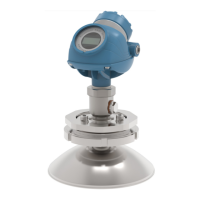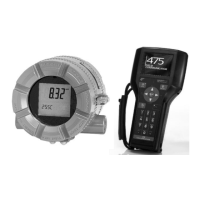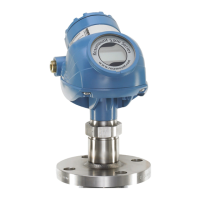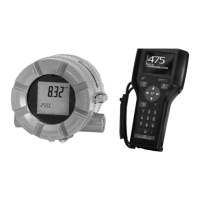108
Reference Manual
00809-0100-4026, Rev KC
Configuration
October 2018
Configuration
Default settings for alarm mode:
Measurement errors: Output current = High
Measured value out of range: transmitter enters saturation mode (if Limit Alarm is disabled)
Table 5-2. Analog Output: Standard Alarm Value vs. Saturation Value
In saturation mode, if the primary variable is not in low alarm mode, the minimum output is
3.9 mA. If the primary variable is not in high alarm mode, the maximum output is 20.8 mA.
Table 5-3. Analog Output: NAMUR-compliant Alarm Value vs. Saturation Value
5.3.6 Level and distance calibration
Level and distance calibration may be necessary when using a nozzle or pipe or if there are disturbances
in the near zone caused by a physical object.
Non-metallic (e.g. plastic) vessels and installation geometry may introduce an offset for the zero
reference point. This offset may be up to ± 25 mm. The offset can be compensated for using Distance
Calibration.
When calibrating the transmitter, it is important that the product surface is calm and that the tank is not
being filled or emptied.
A complete calibration is performed in two steps:
1. Calibrate the distance measurement by adjusting the Calibration Offset parameter.
2. Calibrate the level measurement by adjusting the Tank Height.
Distance calibration
1. Measure the actual distance between the Upper Reference Point and the product surface.
2. Adjust the Calibration Distance so that the Distance measured by the transmitter corresponds to the
actual distance.
The Calibration Distance parameter is available via
HART command [2, 3, 2, 4, 1],
or
RRM:
a. Select the Tank icon under Device Config/Setup in the RRM workspace.
b. In the Tank window, select the Geometry tab.
c. Select the Advanced button.
d. Enter the desired value in the Calibration Distance field and select the Store button.
Level 4–20 mA saturation value 4–20 mA alarm value
Low 3.9 mA 3.75 mA
High 20.8 mA 21.75 mA
Level 4–20 mA saturation value 4–20 mA alarm value
High 20.5 mA 22.5 mA

